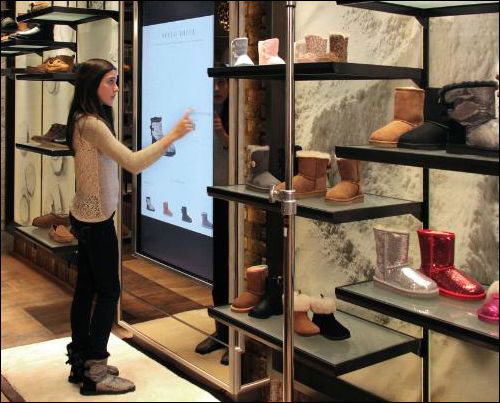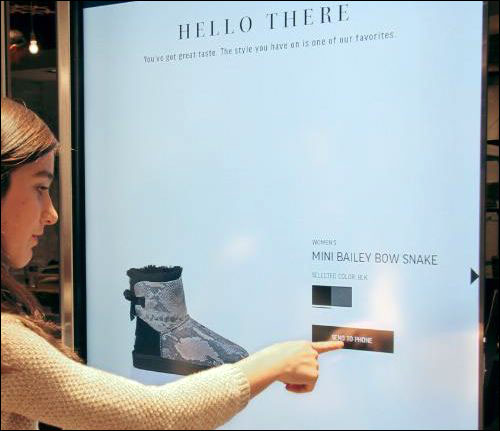Footwear, apparel and accessories company Deckers has adopted a radio frequency identification-based system to promote products at its new UGG Australia store in McLean, Va., near Washington, D.C. The 2,110-square-foot store, which opened this month at the Tysons Galleria, showcases its shoes and boots via RFID tags applied to the soles of the footwear, in order to allow shoppers to view content about a particular tagged item when trying it on near an RFID-enabled touchscreen. The solution was developed by Deckers in partnership with New York technology firm Control Group.
The system will eventually be launched at other Deckers stores as well, if the new UGG Australia store’s technology is well received by customers. The project is part of a drive by Deckers to use technology to make its physical stores a more omni-channel experience.

Deckers launched its innovation lab at its headquarters in Goleta, Calif., in March of this year. There, the company has established a Brand Showcase Store for Deckers’ brands, including UGG Australia, Teva, Sanuk and Hoka One One. At the store, Deckers not only showcases and sells its new products, but also tests new technologies and merchandizing approaches to improve omni-channel solutions. That has included some testing of RFID, says Dave Powers, Deckers’ president of omni-channel.
The UGG Australia store in McLean features only UGG Australia products. Like the Goleta store, it serves as an innovation lab site and focuses on providing omni-channel, high-tech shopping for customers at that location. The RFID solution installed at the Virginia store draws from Decker’s experience in employing RFID at the UGG store in California. It consists of four 65-inch high-definition touchscreens combined with EPC Gen 2 ultrahigh-frequency (UHF) RFID readers, which trigger the display of information about each shoe style, including color options, style tips, videos and suggestions for products that would complement the shoe.
The goal, Powers says, is to make the brick-and-mortar and ecommerce shopping experiences more seamless and connected.
At the Tysons Galleria store, an Impinj Speedway Revolution RFID reader is connected to the antenna built into the floor mat in front of each touchscreen. Staff members at the store attach RFID labels containing a Smartrac MiniWeb inlay to incoming footwear, and use a Zebra Technologies ZD500R RFID printer to encode those labels.
The labels are applied to the soles of footwear, says Charlie Miller, a Control Group associate partner, and the unique ID number encoded to each tag is linked to stock-keeping unit (SKU) data about that particular product, including its size, color and style. When an individual tries on a shoe or boot and steps on the RFID-enabled mat (the tag can be read within 1 or 2 feet of the reader), the reader captures that ID number and forwards it to the software provided by Control Group, residing on a dedicated server. The software then prompts the touchscreen to display content specific to that product.
Consumers also have the option of following prompts on the touchscreen to send themselves text messages containing product links, directly from the Control Group software residing on a centralized content management server. In that way, shoppers can view details about a product they tried on, whether or not they purchase it at the time. The collected data is also forwarded to UGG store managers, enabling them to design promotional campaigns and in-store visuals.
Stores sales representatives carry iPads enabling them to seek additional product information that shoppers request. They can also use devices to help a shopper order an item online if it is unavailable at the store.

The Virginia store itself has approximately 230 unique SKUs, Powers says, but with the staff’s iPad connection, shoppers can potentially view and order any UGG product. The ordered goods could then be shipped overnight for free, or be picked up at the store at a later date.
“We believe this technology is mutually beneficial to both Deckers Brands and the consumer,” Powers says, “from the ‘endless aisle’ of merchandise provided by the Internet connectivity, to the RFID-triggered brand content. We’re helping consumers get the products that they truly want, while engaging with the brand in person.”
The store is considering other future applications for the RFID technology as well. For instance, Miller says, it may opt to integrate antennas into the shelving at some locations, thereby providing additional options for viewing product data. “A sales associate might use this as an assisted sales tool,” he explains. “Placing a shoe on a pedestal, triggering content on a nearby screen that tells a product story, displays related styles or accesses inventory information.”
To date, Powers reports, “consumers enjoy the seamless way that these technologies assist them in making purchases.”



